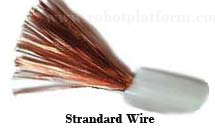Wires

Wire is a basic component used in any of those electronic and electrical equipments. Let us see what a wire is, different types of wires, what cables are, etc.
In simple terms, wire is usually a cylindrical string of metal used to carry electricity or other signals from one end point to another. They are generally covered with an insulating material such as plastic or other rubber resembling polymers, or simply a varnish.  They are very rigid, but are inexpensive with very less resistance. Copper is widely preferred metal in wires due to the reason that resistance in copper is less compared to other metals within an expense range. Ofcourse silver and gold offers better conductivity, but they do come at their own luxurious cost.
They are very rigid, but are inexpensive with very less resistance. Copper is widely preferred metal in wires due to the reason that resistance in copper is less compared to other metals within an expense range. Ofcourse silver and gold offers better conductivity, but they do come at their own luxurious cost.
Another type of wire available in the market is a stranded wire.  Set of metal strands are grouped together to make a stranded wire, which are normally twisted together without an insulating material between them. This adds flexibility to the conductor as compared to a single wire with insulation. They also decrease power loss during transition. Although the resistance in a stranded conductor is more compared to a single wire, a stranded wire is more usable in most applications like circuit boards and electrical appliances. The increased resistance is because stranded wire is not all metal as there will be gaps between each strand. The number of strands determines the flexibility of the wire. A minimum set of wires in a stranded wire is 7 where 6 wires surround a wire to make a stranded wire. Bigger wires will have more layers wrapped around each.
Set of metal strands are grouped together to make a stranded wire, which are normally twisted together without an insulating material between them. This adds flexibility to the conductor as compared to a single wire with insulation. They also decrease power loss during transition. Although the resistance in a stranded conductor is more compared to a single wire, a stranded wire is more usable in most applications like circuit boards and electrical appliances. The increased resistance is because stranded wire is not all metal as there will be gaps between each strand. The number of strands determines the flexibility of the wire. A minimum set of wires in a stranded wire is 7 where 6 wires surround a wire to make a stranded wire. Bigger wires will have more layers wrapped around each.
The third classification in wire is a cable. Cables get their name due to their larger size and are no different than stranded wires. Two or more wires are braided or twisted together and wrapped within a jacket and called a cable.
Do you have anything to say?
Visit the Forum to discuss, learn and share anything related to robotics and electronics !!








